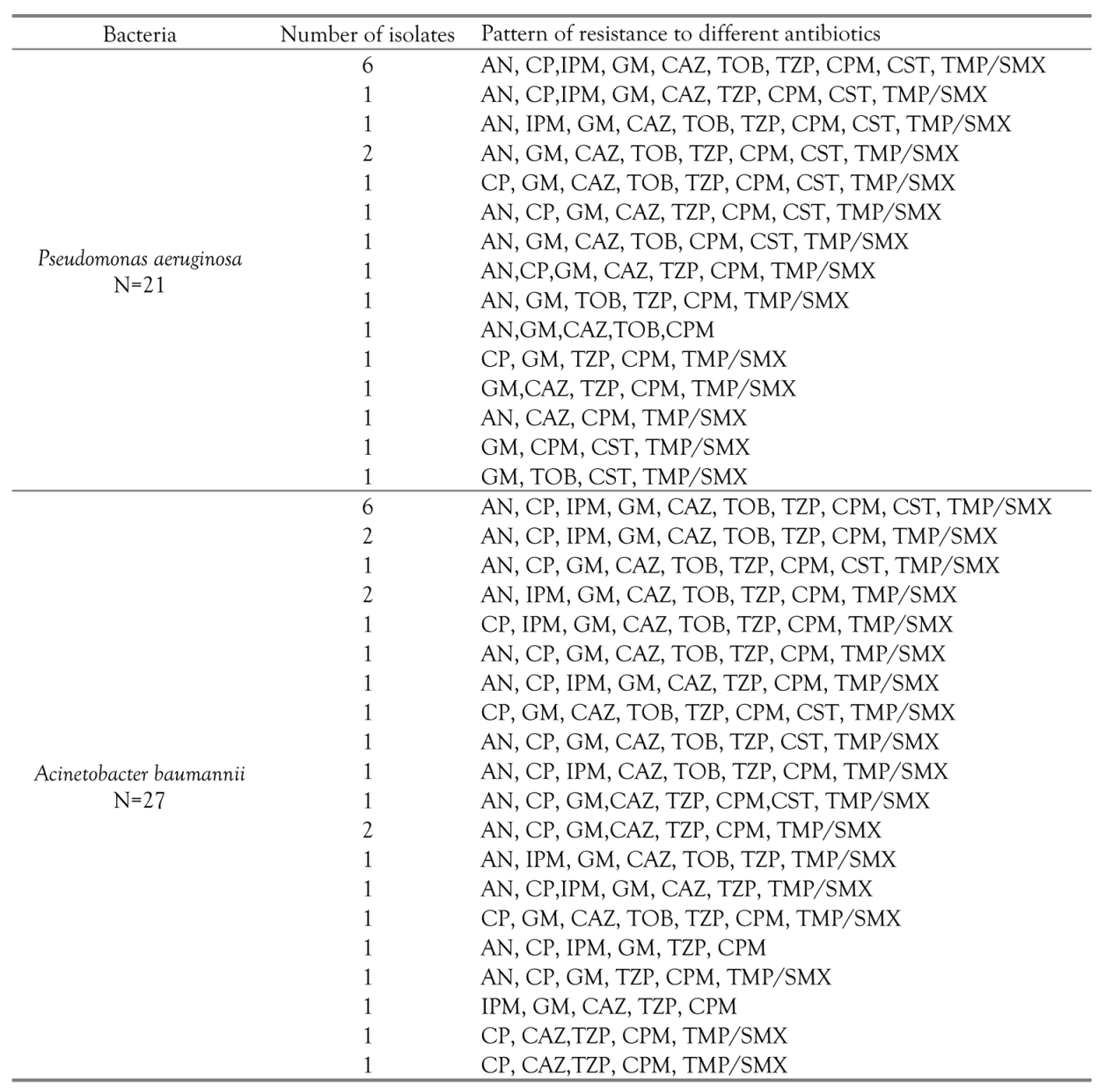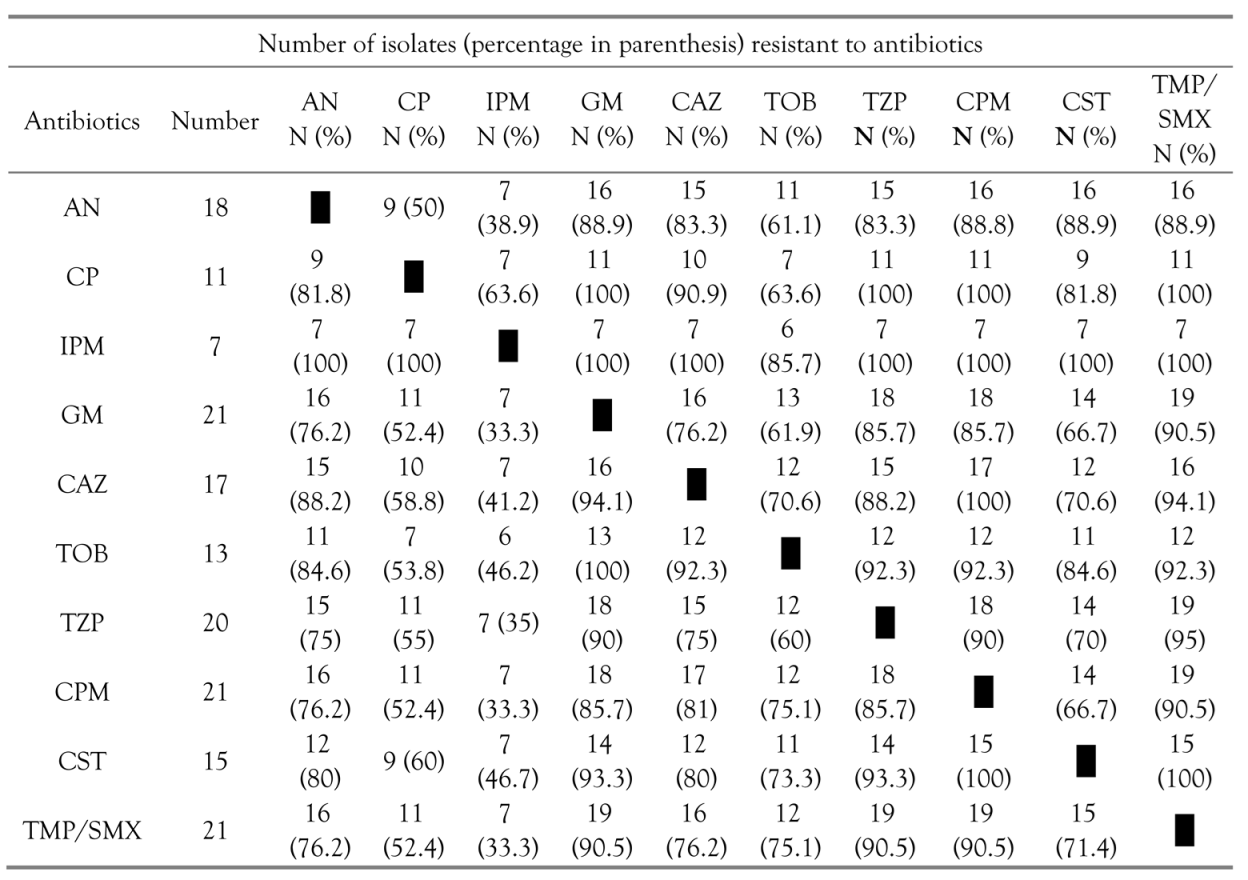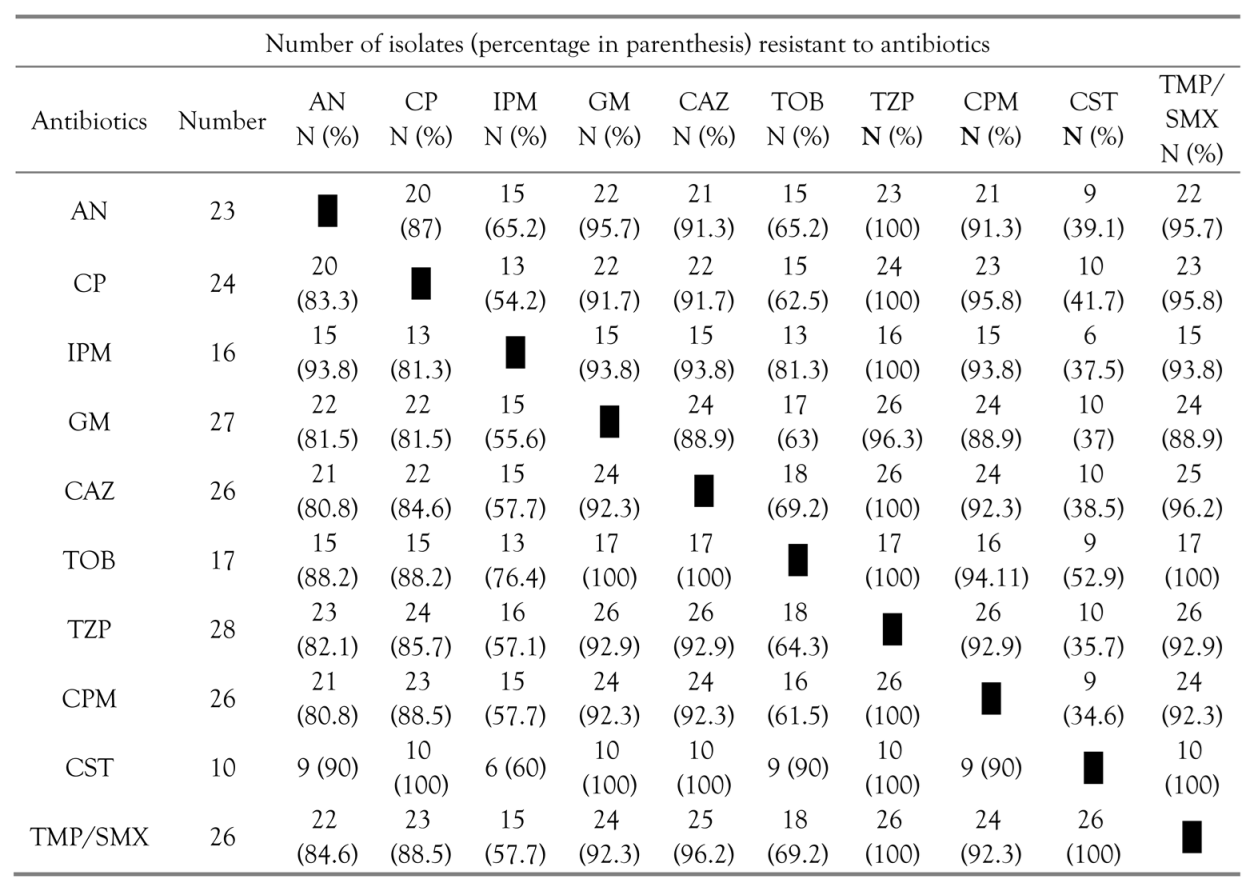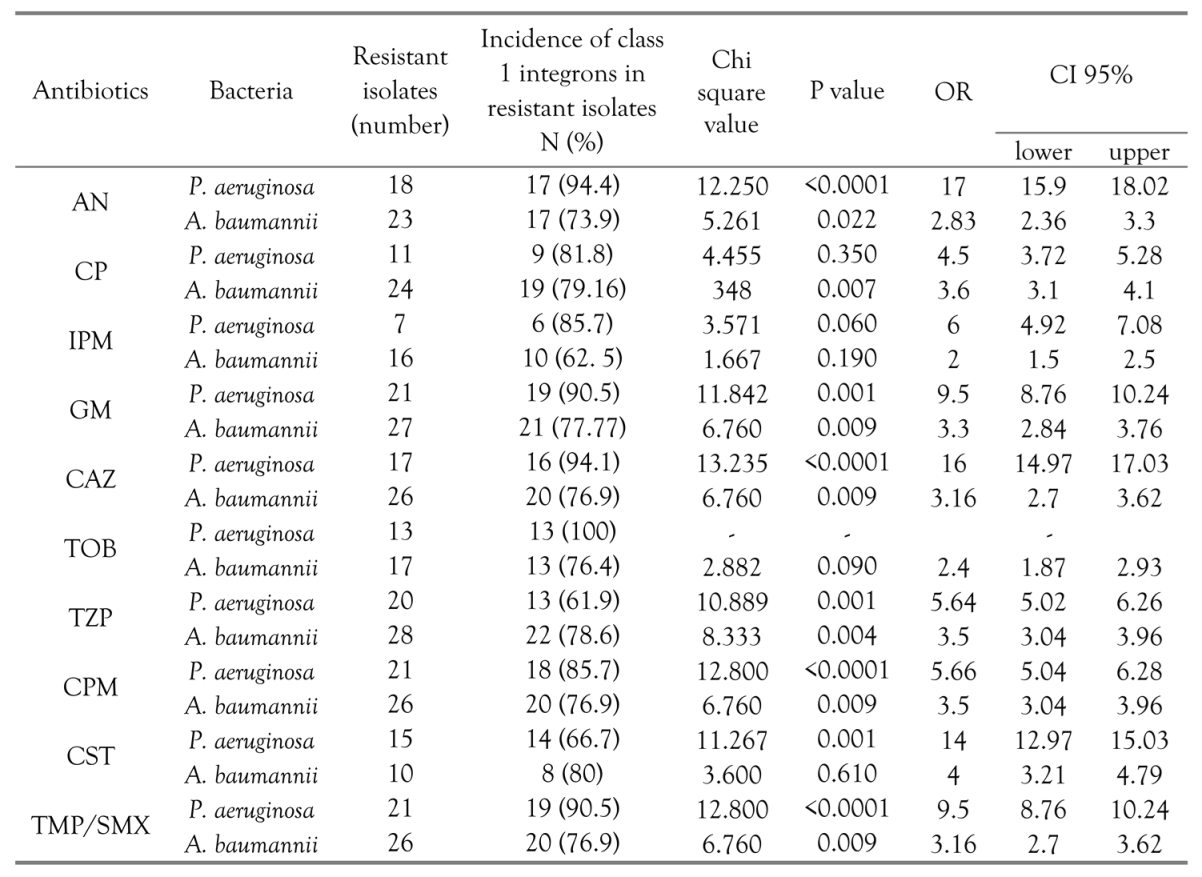Multidrug and Co-Resistance Patterns of Non-Fermenting Gram-Negative Bacilli Involved in Ventilator-Associated Pneumonia Carrying Class 1 Integron in the North of Iran
Abstract
Introduction
Methods
Study population and ethics
Antibiotic susceptibility test, isolation of MDR NFGNB and determination of co-resistance profile
DNA extraction and detection of integron class 1
Statistical analysis
Results
Discussion
Conclusions
Author Contributions
Funding
Conflicts of Interest
References
- Shete, V.B.; Ghadage, D.P.; Muley, V.A.; Bhore, A.V. Multi-drug resistant Acinetobacter ventilator-associated pneumonia. Lung India 2010, 27, 217–220. [Google Scholar]
- Malini, A.; Deepa, E.; Gokul, B.; Prasad, S. Nonfermenting Gram-negative bacilli infections in a tertiary care hospital in Kolar, Karnataka. J Lab Physicians 2009, 1, 62–66. [Google Scholar] [CrossRef]
- Garnacho-Montero, J.; Corcia-Palomo, Y.; Amaya-Villar, R.; Martin-Villen, L. How to treat VAP due to MDR pathogens in ICU patients. BMC Infect Dis 2014, 14, 135. [Google Scholar] [CrossRef]
- Behzadnia, S.; Davoudi, A.; Rezai, M.S.; Ahangarkani, F. Nosocomial infections in pediatric population and antibiotic resistance of the causative organisms in north of Iran. Iran Red Crescent Med J 2014, 16, e14562. [Google Scholar] [CrossRef]
- Rezai, M.S.; Pourmousa, R.; Dadashzadeh, R.; Ahangarkani, F. Multidrug resistance pattern of bacterial agents isolated from patient with chronic sinusitis. Caspian J Intern Med 2016, 7, 114–119. [Google Scholar]
- Bagheri-Nesami, M.; Rafiei, A.; Eslami, G.; et al. Assessment of extended-spectrum β-lactamases and integrons among Enterobacteriaceae in device-associated infections: Multicenter study in north of Iran. Antimicrob Resist Infect Control 2016, 5, 52. [Google Scholar]
- Koneman, E.; Allen, S.; Janda, W.; Schreckenberger, R.; Winn, W. Introduction to microbiology. In Part II, Guidelines for Collection, Transport, Processing, Analysis, and Reporting of Cultures from Specific Specimen Sources, Color Atlas and Textbook of Diagnostic Microbiology, 5th ed.; Koneman, E.W., Alien, S.D., Janda, W.M., Schreckenberger, R.C., Winn, W., Eds.; Lippincott: Philadelphia, 1997; pp. 121–170. [Google Scholar]
- Magiorakos, A.P.; Srinivasan, A.; Carey, R.B.; et al. Multidrug-resistant, extensively drug-resistant and pandrug-resistant bacteria: An international expert proposal for interim standard definitions for acquired resistance. Clin Microbiol Infect 2012, 18, 268–281. [Google Scholar]
- Ramírez-Estrada, S.; Borgatta, B.; Rello, J. Pseudomonas aeruginosa ventilator-associated pneumonia management. Infect Drug Resist 2016, 9, 7–18. [Google Scholar] [PubMed]
- Dellit, T.H. Development of ventilator-associated pneumonia guidelines based on local microbiology and resistance patterns. In Proceedings of the 42nd Annual Meeting of IDSA, Boston, 1 October 2004. [Google Scholar]
- Ebrahimi, M.; Khansari-nejad, B.; Ghaznavi-Rad, E. High frequency of ventilator associated pneumonia nosocomial co-infection caused by methicillin resistant Staphylococcus aureus and carbapenem resistant Acinetobacter baumannii in intensive care unit. J Iran Clin Res 2015, 1, 67–71. [Google Scholar]
- Japoni, A.; Vazin, A.; Davarpanah, M.A.; et al. Ventilator-associated pneumonia in Iranian intensive care units. J Infect Dev Ctries 2011, 5, 286–293. [Google Scholar] [CrossRef] [PubMed]
- Luna, C.M.; Vujacich, P.; Niederman, M.S.; et al. Impact of BAL data on the therapy and outcome of ventilator-associated pneumonia. Chest 1997, 111, 676–685. [Google Scholar] [CrossRef]
- Ahmed, S.S.; Alp, E.; Hopman, J.; Voss, A. Global epidemiology on colistin resistant Acinetobacter baumannii. J Infect Dis Ther 2016, 4, 4. [Google Scholar]
- Reyes, A.; Bello, H.; Domínguez, M.; Mella, S.; Zemelman, R.; González, G. Prevalence and types of class 1 integrons in aminoglycoside-resistant Enterobacteriaceae from several Chilean hospitals. J Antimicrob Chemother 2003, 51, 317–321. [Google Scholar] [CrossRef]
- Lee, M.D.; Sanchez, S.; Zimmer, M.; Idris, U.; Berrang, M.E.; McDermott, P.F. Class 1 integron-associated tobramycin-gentamicin resistance in Campylobacter jejuni isolated from the broiler chicken house environment. Antimicrob Agents Chemother 2002, 46, 3660–3664. [Google Scholar] [CrossRef]
- Mohammadi-Barzelighi, H.; Talebi-Taher, M.; Adabi, M.; Javad-Moosavai, S.; Jabbari, M.; Rastegar-Lari, A. Investigation of class I, II and III integrons among Acinetobacter strains isolated from ventilator-associated pneumonia patients in intensive care unit of Rasoul Akram Hospital in Tehran, Iran. J Med Bacteriol 2012, 1, 1–9. [Google Scholar]
- Farshadzadeh, Z.; Hashemi, F.B.; Rahimi, S.; et al. Wide distribution of carbapenem resistant Acinetobacter baumannii in burns patients in Iran. Front Microbiol 2015, 6, 1146. [Google Scholar] [CrossRef]
- Peymani, A.; Higgins, P.G.; Nahaei, M.R.; Farajnia, S.; Seifert, H. Characterisation and clonal dissemination of OXA-23-producing Acinetobacter baumannii in Tabriz, northwest Iran. Int J Antimicrob Agents 2012, 39, 526–528. [Google Scholar] [CrossRef] [PubMed]
- Shahcheraghi, F.; Badmasti, F.; Feizabadi, M.M. Molecular characterization of class 1 integrons in MDR Pseudomonas aeruginosa isolated from clinical settings in Iran, Tehran. FEMS Immunol Med Microbiol 2010, 58, 421–425. [Google Scholar] [CrossRef] [PubMed]
- Nikokar, I.; Tishayar, A.; Flakiyan, Z.; et al. Antibiotic resistance and frequency of class 1 integrons among Pseudomonas aeruginosa, isolated from burn patients in Guilan, Iran. Iran J Microbiol 2013, 5, 36–41. [Google Scholar] [PubMed]
- Doosti, M.; Ramazani, A.; Garshasbi, M. Identification and characterization of metallo-β-lactamases producing Pseudomonas aeruginosa clinical isolates in University Hospital from Zanjan Province, Iran. Iran Biomed J 2013, 17, 129–133. [Google Scholar]
- Moazami Goudarzi, S.; Eftekhar, F. Multidrug resistance and integron carriage in clinical isolates of Pseudomonas aeruginosa in Tehran, Iran. Turk J Med Sci 2015, 45, 789–793. [Google Scholar] [CrossRef] [PubMed]
- Gu, B.; Tong, M.; Zhao, W.; et al. Prevalence and characterization of class I integrons among Pseudomonas aeruginosa and Acinetobacter baumannii isolates from patients in Nanjing, China. J Clin Microbiol 2007, 45, 241–243. [Google Scholar] [CrossRef] [PubMed]
- Rezai, M.S.; Salehifar, E.; Rafiei, A.; et al. Characterization of multidrug resistant extended-spectrum beta-lactamase-producing Escherichia coli among uropathogens of pediatrics in North of Iran. Biomed Res Int 2015, 2015, 309478. [Google Scholar] [CrossRef] [PubMed]
 |
 |
 |
 |
© GERMS 2017.
Share and Cite
Bagheri-Nesami, M.; Rezai, M.S.; Ahangarkani, F.; Rafiei, A.; Nikkhah, A.; Eslami, G.; Shafahi, K.; Hajalibeig, A.; Khajavi, R. Multidrug and Co-Resistance Patterns of Non-Fermenting Gram-Negative Bacilli Involved in Ventilator-Associated Pneumonia Carrying Class 1 Integron in the North of Iran. Germs 2017, 7, 123-131. https://doi.org/10.18683/germs.2017.1117
Bagheri-Nesami M, Rezai MS, Ahangarkani F, Rafiei A, Nikkhah A, Eslami G, Shafahi K, Hajalibeig A, Khajavi R. Multidrug and Co-Resistance Patterns of Non-Fermenting Gram-Negative Bacilli Involved in Ventilator-Associated Pneumonia Carrying Class 1 Integron in the North of Iran. Germs. 2017; 7(3):123-131. https://doi.org/10.18683/germs.2017.1117
Chicago/Turabian StyleBagheri-Nesami, Masoumeh, Mohammad Sadegh Rezai, Fatemeh Ahangarkani, Alireza Rafiei, Attieh Nikkhah, Gohar Eslami, Kheironesa Shafahi, Azin Hajalibeig, and Rezvan Khajavi. 2017. "Multidrug and Co-Resistance Patterns of Non-Fermenting Gram-Negative Bacilli Involved in Ventilator-Associated Pneumonia Carrying Class 1 Integron in the North of Iran" Germs 7, no. 3: 123-131. https://doi.org/10.18683/germs.2017.1117
APA StyleBagheri-Nesami, M., Rezai, M. S., Ahangarkani, F., Rafiei, A., Nikkhah, A., Eslami, G., Shafahi, K., Hajalibeig, A., & Khajavi, R. (2017). Multidrug and Co-Resistance Patterns of Non-Fermenting Gram-Negative Bacilli Involved in Ventilator-Associated Pneumonia Carrying Class 1 Integron in the North of Iran. Germs, 7(3), 123-131. https://doi.org/10.18683/germs.2017.1117




